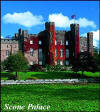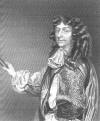|
Worcester 3 Sep 1651.
 King King
Charles was crowned at Scone, Perthshire on 1 January 1651
and once again Scotland was supporting its king against
the New Model Army of Cromwell. In the June of 1651 the
Act of Classes, which had excluded so many from
recruitment to the army, was repealed. A new army was
levied from new sources but again they were poorly trained
and soon paid the price. Cromwell saw the danger that the
Scots might unite with royalist supporters in England and
sought to make an early attack on them. The Scots army was
located at Torwood, north of Falkirk, and able to
cover the defence of Stirling. On 15 July Cromwell sent a
scouting party of some 5000 men under Lt Gen. Lambert into Fifeshire with the intention of cutting the supply lines
of the Scots. The Scots detached a party of some 4000 to
head off the English but it was the English forces that
attacked first and routed them. On 20 July at
Inverkeithing, the Lowland troops, mostly poorly trained
levies, turned tail and fled leaving the Clansmen of
Buchanan (700) and MacLean (800) to be slaughtered.
About 2000 were killed and over 1500 were taken prisoner
including their commander Sir John Brown. This served to
show Cromwell the poor quality of the Scottish forces that
faced him; encouraged by this, Cromwell advanced towards
Perth which fell on 2 August.
There is debate whether
Cromwell deliberately left the way open
 for for
the Scots army to escape from Stirling or whether there
was a double bluff by David Leslie that drew Cromwell into
Fife to leave open a route south. One hypothesis is that
it would be better to defeat a Scots army in England –
where they would be seen as foreign invaders more than
royalist supporters. This would help to counteract the
pockets of royalist support that existed in Lancashire,
Cumbria, Wales and the South West of England. On the
evening of 31 July David Leslie and the Scots army of
20,000 and the King, headed for England.
By 6 August they had reached Carlisle where the
gates to the city remained shut to them and the army
itself was reduced by sickness and desertions to no more
than 13,000.
Fortune turned against Charles
at this juncture as probably less than 2000
supporters came to his flag when many more had been
expected. But it appears that possibly 3,000 Englishmen
joined him between Lancashire and arrival at Worcester. It
did not help recruitment along the way that the Scots were
unpopular, and there was jealousy between the
Presbyterians and the royalist `cavaliers`. In Lancashire
Charles was very tactless when he sought assistance from
Catholic supporters and stayed at Catholic homes. The main
supporter to emerge was the Earl of Derby who joined the
ranks with some 300 men. Militarily the Scots swift march
south was mirrored by the English armies who had been
warned of the possibility this might happen. General
Harrison marched from Leith to Newcastle by 5 August
and made up two days on the Scots. Lt. General Lambert
meanwhile had made up five days in five and was at
Penrith, just a day behind, on 9 August. Not to be outdone
Cromwell and his forces left Leith on 6 August, and rested
in Ryton, Newcastle on Tyne on 13 August, covering over a
hundred miles in six days. Harrison and his army moved
across to join Lambert in Lancashire and they were joined
by Colonel Lilburne`s regiment. Now a substantial force,
the English nevertheless continued to shadow the Scots as
they headed south. Meanwhile the English Council of State
had called up forces from all over the country to assorted
rendezvous. Under the command of General Fleetwood the
English southern army congregated at Banbury where they
were soon joined by others. On 24 August they were at
Warwick ready for battle, and joined by Cromwell. The
combined forces were twice those of the Scots
At Worcester on 3 September
1651, Cromwell caught up with the Scots army
and annihilated it, taking some 10,000 prisoners and
killing another 3,000. Leslie had drawn up his army
on the western bank of the River Severn, in a corner where
the River Teme joined. He had meanwhile destroyed the
bridge over the Teme to hinder Cromwell who was drawn up
to the east. Cromwell again displayed his generalship and
attention to detail by dividing his force into three; one
division lay across the road to London, another moved
south and lay ready to cross the River Severn , and the
third went south crossed, and marched up the River Teme.
The crossings were made by making bridges from boats on
the rivers – a forerunner to the modern pontoon or
Bailey bridges. Resistance from the Scots was strong as
they were forced back through the hedgerows into Worcester
City where King Charles watched the battle from the
cathedral tower. He, himself, went and led a charge
against the English who at first gave way. However,
Cromwell led reinforcements over the boat bridges
and repelled the Scots and made them break. The
`Ironsides` ( as Cromwell`s troops were called) cut the
Scots to pieces; then the guns were turned on the royalist
troops fleeing through the streets. The fleeing Scots were
caught in traps that had been prepared with few
escaping death or capture, and the local peasantry helped
to wipe out what was left while taking all the
baggage and munitions.
Among the prisoners taken
were General David Leslie, the Earl of Rothes, the Earl
(later Duke) of Lauderdale, the Earl of Kellie, John
Middleton (later Earl), Viscount Montgomery, Thomas
Dalziel of the Binns, many officers and nine ministers.
The Duke of Hamilton died of his wounds after four days,
but the Earl of Derby recovered enough to be executed on
the block at Bolton. The other lordly prisoners were
incarcerated in the Tower of London. Middleton was
very popular among the royalist officers and showed
considerable bravery. This was said ( sarcastically ?) to
have been because he stayed off the drink while on the
campaign. At Worcester he was a prominent leader with the
Scottish forces and was wounded in the process. After the
battle he joined Leslie`s troops and tried to make his way
back to Scotland. However, he and Lelsie were captured by
the English near Halifax. Middleton was first imprisoned
in Liverpool and then transferred to the Tower. By the end
of 1651 he managed to escape from the Tower and joined the
King in exile.
 David David
Leslie had fallen out of favour because of his continuing
commitment to the Presbyterians and, while in winter
quarters, several enemies of his gained promotion to
positions of influence. At Worcester he was in command of
the 1st Cavalry Brigade but spent much time falling
out with his officers and complaining that the cavalry he
had looked the part but would not fight. Before the battle
he seemed to be in a quandry because the King had
attended an Anglican church service, much to the annoyance
of the Scottish ministers present. Leslie may also have
been thinking of another defeat at the hands of Cromwell.
In the event he issued, retracted and reissued confused
orders and failed to send support to Middleton and
Hamilton when it was needed. Possibly through a
nervous breakdown, Leslie did not commit his 4000 cavalry
to the battle and then fled north with his demoralised
horsemen. Along with Middleton he ended up in the Tower,
where he remained until the Restoration of 1660. The
following year he was made Lord Newark by Charles II and
given a pension of £500 a year.
King Charles escaped at
Worcester and began his romanticised adventure dressed as
a common labourer, sleeping in hedgerows and famously in
an oak tree. Charles and his companion Wilmot, reached
France on 16 October, not to return until his Restoration
in 1660.
By 16 September the Council
decided that all prisoners below the rank of Captain were
to be sent to the plantations, with the intention of
getting rid of as many as possible in the shortest time.
Those at Chester, Worcester, Liverpool and Shrewsbury were
sent to Bristol for onward consignment to Virginia and
Bermuda. Three hundred were sent to New England and
the Saugus Iron Works where they were sold on as slaves to
farmers and mill owners. A thousand others were put to
work digging drains in the Fenlands. The great majority of
Scots prisoners simply did not return home, the rest dying
of wounds, illness, neglect, or overwork.
In Scotland General Monck`s
army sacked Dundee on 1 September and butchered 800 Scots
in the process, having earlier captured the Committee of
Estates ( the Scottish Parliamentary leaders) at Alyth and
isolated the nobles. The Marquis of Argyll was forced to
submit and became a prisoner in his own lands. The English
army marched to Orkney with little resistance and Scotland
surrendered to its fate. With victory came the end of the
Anglo Scottish War and the exile of Charles. It also
brought to Scotland a firm, disciplined, impartial and
religiously tolerant government that had not been enjoyed
for years. Viceroy of Scotland was Gen. Monck who would
later recognise the need for a unifying monarchy and be
instrumental in the Restoration of Charles II in 1660.
The singular consequence of
the crushing defeats at Dunbar and Worcester
was the loss of some 20,000 men – roughly 10 per
cent of the total adult male population. This loss of the
predominantly younger men was a catastrophe for Scotland
and took a further generation to recover. This undoubtedly
contributed to the peace that fell on Scotland during the
Cromwellian rule. There had already been fourteen years of
confrontations during the Second Reformation, the Bishops
Wars and the First English Civil War – sheer exhaustion
had sapped the will of the country to resist further.
|